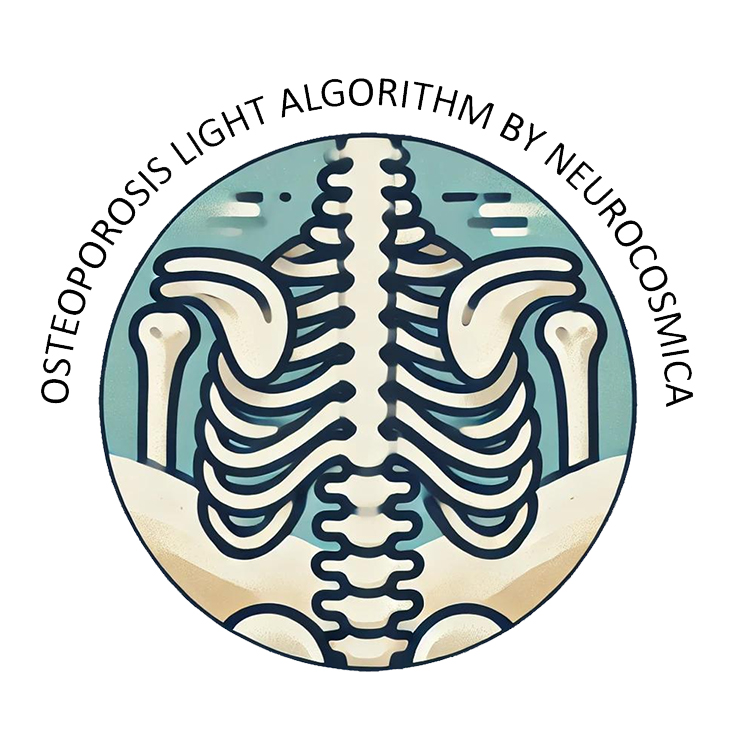NeuroCosmica: Osteoporosis Light Algorithm
Brief Description of Osteoporosis: Osteoporosis is a condition characterized by weakened bones, making them fragile and more prone to fractures. This condition often develops silently over several years and is typically diagnosed when a minor fall or sudden impact causes a bone fracture. Common areas affected include the hip, wrist, and spine. Symptoms may include back pain, loss of height over time, a stooped posture, and bones that break more easily than expected.
Causes of Osteoporosis: Several factors can contribute to the development of osteoporosis:
- Age: Bone density decreases with age.
- Gender: Women are at higher risk, particularly postmenopausal women due to lower estrogen levels.
- Family History: A family history of osteoporosis can increase the risk.
- Hormonal Imbalances: Low levels of sex hormones, thyroid problems, and overactive adrenal glands can contribute.
- Dietary Factors: Insufficient calcium and vitamin D intake.
- Sedentary Lifestyle: Lack of physical activity can weaken bones.
- Smoking and Alcohol: Tobacco use and excessive alcohol consumption can weaken bones.
- Certain Medications: Long-term use of corticosteroids and other medications can affect bone health.
Recommended Exercise Routine for Individuals with Osteoporosis: Regular physical activity can help strengthen bones, improve balance, and reduce the risk of fractures. Here are some exercise recommendations:
- Weight-Bearing Exercises: Engage in weight-bearing activities like walking, dancing, low-impact aerobics, and stair climbing to strengthen bones and muscles.
- Strength Training: Include strength training exercises two to three times a week to build muscle mass and support bone health. Use light weights or resistance bands for exercises like squats, lunges, and bicep curls.
- Flexibility Exercises: Incorporate stretching exercises to improve flexibility and reduce the risk of falls. Gentle yoga and stretching can enhance mobility.
- Balance Exercises: Perform balance exercises to prevent falls and improve stability. Simple exercises include standing on one foot, heel-to-toe walking, and tai chi.
- Posture Exercises: Engage in posture-improving exercises to strengthen the back and core muscles, reducing the risk of spinal fractures. Exercises like Pilates can be beneficial.
- Consistency: Maintain a regular exercise routine, but listen to your body and avoid overexertion. Modify exercises as needed based on energy levels and physical condition.
Healthy Diet Recommendations for Individuals with Osteoporosis: A balanced diet can support overall bone health, enhance recovery, and prevent further bone loss. Here are some dietary recommendations:
- Calcium-Rich Foods: Consume calcium-rich foods such as dairy products (milk, cheese, yogurt), leafy green vegetables (kale, broccoli), almonds, and fortified foods (orange juice, cereals).
- Vitamin D: Include sources of vitamin D like fatty fish (salmon, mackerel), egg yolks, and fortified foods. Consider supplements if needed, especially if sun exposure is limited.
- Protein: Ensure adequate protein intake from sources such as lean meats, fish, poultry, beans, and legumes to support muscle health and repair.
- Fruits and Vegetables: Consume a variety of colorful fruits and vegetables rich in vitamins, minerals, and antioxidants to support overall health and reduce inflammation.
- Healthy Fats: Incorporate healthy fats from sources like olive oil, avocados, nuts, and seeds to support bone health and reduce inflammation.
- Hydration: Drink plenty of water to stay hydrated and support overall bodily functions.
- Limit Caffeine and Alcohol: Reduce intake of caffeine and alcohol, as excessive amounts can interfere with calcium absorption and bone health.
- Magnesium and Zinc: Include foods rich in magnesium (nuts, seeds, whole grains) and zinc (meat, shellfish, dairy) to support bone health.
NeuroCosmica: Potential Benefits of Light Algorithms for Osteoporosis:
1. Enhancing Bone Health: Light algorithms can use specific colors like red and infrared to promote bone health and support the body’s natural healing processes.
2. Reducing Pain and Inflammation: Light therapy can help reduce the pain and inflammation associated with osteoporosis, providing relief from symptoms and improving quality of life.
3. Enhancing Mood and Reducing Stress: Managing osteoporosis can be stressful. Light therapy with calming colors such as blue and violet can help alleviate stress and promote relaxation, which can positively impact overall well-being.
4. Improving Sleep Quality: Osteoporosis can disrupt sleep due to pain and discomfort. Light therapy can help regulate circadian rhythms and improve sleep quality, leading to better rest and overall health.
5. Supporting Immune Function: A strong immune system is crucial for managing osteoporosis. Light therapy can support immune function, helping the body to better manage symptoms and recover more quickly.
6. Promoting Emotional Balance: Emotional stability is crucial for managing osteoporosis. Light algorithms can help regulate emotions, preventing mood swings and fostering a balanced emotional state.
7. Enhancing Mental Clarity and Focus: Managing the demands of osteoporosis can cause stress and affect cognitive functions. NeuroCosmica’s light therapy can enhance mental clarity and cognitive functions, making it easier to stay focused and productive.
8. Encouraging Positive Mindset: A positive mindset can significantly impact the well-being of individuals with osteoporosis. Light therapy can promote feelings of optimism and resilience, helping them approach their condition with a positive attitude.
9. Creating a Positive Environment: Using light therapy to create a serene and uplifting environment can enhance overall satisfaction and comfort during osteoporosis management.
Integrating NeuroCosmica’s Light Algorithms into the care plan for individuals with osteoporosis can provide a unique and effective approach to enhancing their overall well-being. The holistic benefits of light therapy address various aspects of health, helping to reduce pain, support bone health, improve mood, and ultimately improve the quality of life for those managing osteoporosis.
Important Note: Remember that NeuroCosmica treatments and/or recommendations should not replace the recommendations, treatments, and prescriptions of your doctor, specialist, psychologist, or other professional currently treating you.





Reviews
There are no reviews yet.